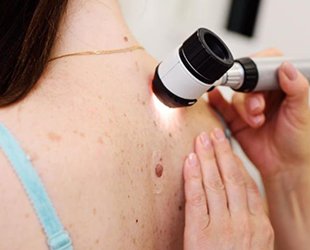Squamous Cell Carcinoma
Squamous cell carcinoma is the second most common form of skin cancer. While it can be aggressive, it is usually not life-threatening and is typically curable when detected early. Our surgeons at South Bay Skin Cancer & Melanoma Institute, treat a variety of skin cancers by providing tailored treatment for our patients.
The second most common form of skin cancer is squamous cell carcinoma (SCC). SCC is the abnormal and rapid growth of squamous cells and is typically curable when detected early.
The squamous cells are one of the types of cells in the outermost layer of skin, or epidermis, that are continually shedding as new ones are developing.
SCC is caused when the UV rays of the sun or tanning beds or other hazardous exposure damages the DNA and causes the squamous cells to change abnormally. SCCs will most commonly appear in the areas of the body that are most often exposed to the sun.
The appearance of SCCs may be in the form of raised growth with an indent in the center, open sores, scaly red patches, or rough, thickened skin. SCCs may become itchy or bleed or crust.
To look for signs of SCC, your doctor will conduct a physical examination and ask questions about your health history. If there is a suspicious skin lesion, your doctor will collect a biopsy by cutting away some or all of the lesion, then send the sample of tissue to a laboratory for examination to confirm a squamous cell carcinoma diagnosis.
Most SCCs are easy to treat successfully through minor surgery or with medicine. The specific treatments will depend on the size, location, and aggressiveness of the tumor and the preferences of the patient. However, if SCCs go untreated, it is possible they will continue to grow and develop deep into the skin and spread to other parts of the body, which can become dangerous or cause disfiguration or death.
Basal Cell Carcinoma
Basal cell carcinoma (BCC) is a result of abnormal and uncontrolled basal cell growth. Over 4 million cases are diagnosed in the U.S. each year, making BCC the most common form of skin cancer.
Most BCCs, when detected and treated early, are able to be cured, resulting in minimal damage.
The key to early detection, treatment, and cure is to understand what causes BCC, as well as the risk factors and warning signs to watch for.
Basal cell carcinoma (BCC) is a result of abnormal and uncontrolled basal cell growth. Over 4 million cases are diagnosed in the U.S. each year, making BCC the most common form of skin cancer.
Most BCCs, when detected and treated early, are able to be cured, resulting in minimal damage.
The key to early detection, treatment, and cure is to understand what causes BCC, as well as the risk factors and warning signs to watch for.
Basal cells are one of the types of cells in the outermost layer of skin, or epidermis. BCCs are most often caused by exposure to UV rays, either from the sun or tanning beds, that damage the DNA and cause changes to the basal cells, producing uncontrolled growth.
BCCs will most commonly be found in the areas of the body that receive the most sun exposure. BCCs may appear brown in color in patients with darker skin. The appearance of BCCs may resemble scars, open sores, shiny bumps, pink growths, red patches, or growths with elevated, rolled edges, possibly with an indent in the center. BCCs have the potential to become itchy or bleed, ooze, or crust.
BCCs typically do not spread beyond the original tumor site. However, if BCCs go untreated, it is possible they will continue to grow and may become dangerous and even cause disfiguration. If a BCC is allowed to grow, it can develop deep into the skin, destroying bone, tissue, and skin. If left untreated over time, BCCs are more likely to return.
Your doctor will complete a medical history and a physical examination to assess any lesions and to look for other suspicious growths. A small sample of the skin may be taken for laboratory testing to determine if skin cancer is present.
The type of treatment will depend on the location, type, and size of cancer. The goal of treatment is to completely remove the cancer. Treatment options may include surgery, curettage and electrodesiccation (C andE), radiation, freezing, topical treatments, and photodynamic therapy. In rare instances, BCC may spread to lymph nodes and other areas of the body. If this occurs, additional treatment options include targeted drug therapy and chemotherapy.
Melanoma
Melanoma is a serious and potentially deadly kind of skin cancer, but there is hope. The surgeons at Association of South Bay Surgeons check irregular moles, diagnose melanoma, and provide effective treatments like excisional skin biopsy when they’re needed.
Melanoma is a type of aggressive skin cancer. This type of cancer comes from cells that produce skin color. The cause of this skin cancer is likely from overexposure to the sun and its powerful ultraviolet (UV) rays. The damage from overexposure to the sun can lead to moles or skin changes. Not all moles are cancerous, but those with unusual characteristics may indicate melanoma. It is highly recommended to get your skin checked regularly, especially if you are under the sun a lot or frequent the tanning salon.
The cause of malignant melanoma is the uncontrolled expansion of the melanocytes, the pigment cells of the skin. Studies suggest that UV radiation is a major contributor to this melanocyte growth. Both sun exposure and tanning beds may cause melanomas. UV radiation damages the DNA within the cells, and this results in mutations in the genes. As the rapid cellular division occurs, those mutations are transmitted to new sets of cells. Soon, the growth rate can be uncontrollable, resulting in tumors.
Usually, there are no symptoms associated with melanoma until late stages of the disease.
Only a doctor can diagnose malignant melanomas. Malignant melanoma is typically asymmetrical, has an irregular border, has more than one color, and is more than 6 mm in size. Patients should also keep a close watch on wounds as they heal because slow-healing lesions may indicate melanoma. The doctor performs both a visual exam and another type of skin exam, such as a dermatoscopic exam. Growths that are suspected to be malignant melanomas are typically biopsied.
The treatment of this disease usually requires a team of physicians such as a dermatologist, oncologist, and surgeon. However, once diagnosed with melanoma, the only cure is complete resection. This will require a wide resection around the melanoma skin site. Also, melanoma travels from the original location to other locations in the body through lymph nodes. If the melanoma is deep enough on the skin, it may be necessary to check and remove several surrounding lymph nodes to see if the melanoma has not spread.
Aside from surgery, other medical treatments such as chemotherapy, immunotherapy, and radiation therapy may play a supporting role.
This will depend on the location of the melanoma and whether or not lymph nodes will need to be taken. Also, at times if the site of the melanoma is on the face or is large, a plastic surgeon may be needed for reconstruction.
For the majority of patients with skin melanoma, patients usually return home 2-3 hours after surgery. Select few may require an overnight stay in the hospital depending on if or how many lymph nodes are taken and how large the skin resection is. Most patients have mild surgery incision site pain lasting 3-5 days and usually resume full physical activity within 2-3 weeks.





Leave a Reply